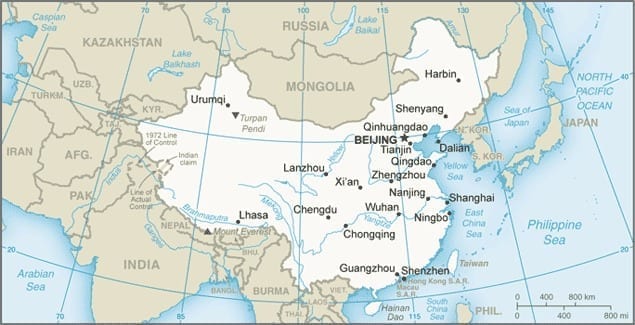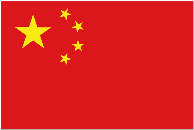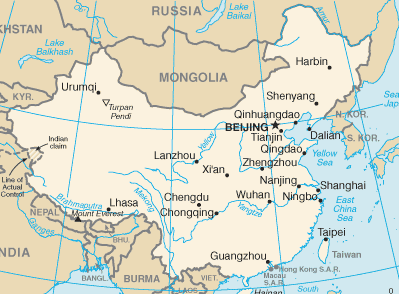Official Name: People’s Republic of China
National Symbol: No official symbol, however the Dragon and the Panda are two important unofficial symbols.
Internet Domain: .cn
International Dialing Code: +86
| General Info | Interesting Facts | Risk Assessment |
| Location and Size | Economy | Business Climate |
| Government | Comparative Indicators | Business Protocol |
| Legal System | Credit and Collections | Other Sources of Info |
12345
Location and Size
Located in Eastern Asia, China covers an area of approximately 9.6 million square kilometers (3.7 million square miles), making it slightly smaller than the United States. Countries bordering China include: Afghanistan, Bhutan, Burma, India, Kazakhstan, North Korea, Kyrgyzstan, Laos, Mongolia, Nepal, Pakistan, Russia, Tajikistan, and Vietnam.
Government
China is a communist state governed by the Chinese Communist Party (CCP). It is comprised of 23 provinces; 5 autonomous regions, and 4 municipalities. China considers Taiwan to be its 23rd province. The branches of government are as follows:
- Executive: President: XI JINPING (since March 14, 2013); Head of Government – Premier LI KEQIANG (since March 16, 2013); Cabinet ” called the State Council is appointed by National People’s Congress.
- Legislative: Unicameral National People’s Congress (2,987 seats; members elected by municipal, regional, and provincial people’s congresses, and People’s Liberation Army to serve five-year terms). In practice, only members of the CCP, its eight allied parties, and CCP-approved independent candidates are elected.
- Judicial: Supreme People’s Court consisting of over 340 judges including the chief justice. In October 2012, China issued a white paper on planned judicial reform.
Legal System
China has a civil law system influenced by Soviet and continental European civil law systems. The legislature retains power to interpret statutes. Its criminal procedure law was revised in early 2012.
China has not accepted compulsory International Court of Justice (ICJ) jurisdiction. (What does this mean?) ICCt does not accept jurisdiction.
Interesting Facts About China
- China is considered by many historians to be the longest continuous civilization.
- The Chinese invented paper, the compass, gunpowder and printing. Toilet paper was also invented in China in the late 1300s, but it was for emperors only.
- Cricket fighting is a popular amusement in China. Many Chinese children keep crickets as pets.
- Despite its size, all of China is in one time zone.
- The Chinese color for mourning and funerals is white rather than black.
- Martial arts are practiced throughout China and were largely developed from ancient farming and hunting methods.
- The most important holiday in China is the Lunar New Year, often referred to as the Chinese New Year.
- Originating as far back as 250 B.C., Chinese lanterns were an important symbol of long life. Lanterns were once symbols of a family’s wealth, and the richest families had lanterns so large, it required several people with poles to hoist them into place.
- China has the world’s oldest calendar. This lunar calendar originated in 2600 B.C. and has 12 zodiac signs.
- The carp is a symbol of strength and perseverance. The scales and whiskers of the fish make it resemble a dragon, the greatest symbol of power in China. Fish in general play a large role in Chinese culture.
- The early Chinese emperors kept pandas to ward off evil spirits and natural disasters. Pandas also were considered symbols of might and bravery.
Economy
Since the late 1970’s, China has moved from a closed and centrally planned system to a more market-oriented economy. Reforms which began by phasing out collectivized agriculture eventually reached out to include fiscal policies, banking, foreign trade and investment which stimulated a rapid growth of the private sector. As a result, China now plays an important global role.
The Chinese government faces numerous economic challenges. These include finding a balance between an aging population and a shrinking pool of abundant cheap labor, and sustaining adequate job growth for the tens of millions of new entrants into the work force who are looking for more globally competitive wages.
While the country is benefiting from competitiveness and industrial diversification, overcapacity in industry and trade are beginning to have an effect. Since the beginning of the year, the volume of raw material imports is down, confirming the reduction in demand from the industrial sector. With regard to growth rate, key indicators for the first four months of 2013 reveal an outcome below expectations.
Leading Markets (2017): U.S. 19%, Hong Kong 12.4%, Japan 6%, South Korea 4.5%
Leading Exports – Commodities: Electrical and other machinery, including data processing equipment, apparel, radio telephone handsets, textiles, integrated circuits
Leading Suppliers (2017): South Korea 9.7%, Japan 9.1%, US 8.5%, Germany 5.3%, Australia 5.1%
Leading Imports – Commodities: Electrical and other machinery, oil and mineral fuels, optical and medical equipment, metal ores, motor vehicles
Top Industries: World leader in gross value of industrial output; mining and ore processing, iron, steel, aluminum, and other metals, coal; machine building; armaments; textiles and apparel; petroleum; cement; chemicals; fertilizers; consumer products, including footwear, toys, and electronics; food processing; transportation equipment, including automobiles, rail cars and locomotives, ships, and aircraft; telecommunications equipment, commercial space launch vehicles, satellites
Top Agricultural Products: World leader in gross value of agricultural output; rice, wheat, potatoes, corn, peanuts, tea, millet, barley, apples, cotton, oil seed; pork; fish
Comparative Economic Indicators 2018
| China | Hong Kong | India | Pakistan | Russia | Vietnam | |
| Population (millions)* | 1,402.1 | 7.2 | 1,296.8 | 207.8 | 142.1 | 97.0 |
| Population growth rate (%)* | 0.37 | 0.29 | 1.14 | 1.41 | -0.11 | 0.9 |
|
Age Structure (%)
(15 to 64 years old)
|
71.5 | 70.4 | 66.6 | 64.6 | 68.1 | 70.4 |
|
Age Structure (%)
(65+ years old)
|
11.2 | 17.1 | 6.3 | 4.5 | 14.6 | 6.35 |
| Literacy (%) | 96.4 | 99.0 | 71.2 | 57.9 | 99.7 | 94.5 |
| Unemployment rate (%) | 5 | 3.1 | 8.5 | 6.0 | 5.2 | 2.2 |
| Inflation (%) | 2.4 | 1.5 | 3.6 | 4.1 | 3.7 | 3.5 |
| Population below poverty line (%) | 3.3 | 19.9 | 21.9 | 29.5 | 13.3 | 8.0 |
| GDP** (USD billions) | 24,142.83 | 455.9 | 9,474.0 | 1,061.0 | 4,016.0 | 648.7 |
| GDP real growth rate (%) | 6.9 | 3.8 | 6.7 | 5.4 | 1.5 | 6.8 |
| GDP per capita** (USD) | 17,192.0 | 61,500.0 | 7,200.0 | 5,400.0 | 27,900.0 | 6,900.0 |
| Public debt (% of GDP) | 66.8 | 0.1 | 71.2 | 67.0 | 15.5 | 48.2 |
| Industrial production growth rate (%) | 6.1 | 1.7 | 5.5 | 5.4 | -1.0 | 8.0 |
| Exports (USD billions) | 27,323.0 (2020 est.) | 537.8 | 304.1 | 32.88 | 353.0 | 214.1 |
| Imports (USD billions) | 23,626.0 (2020 est.) | 561.8 | 425.2 | 53.11 | 238.0 | 202.6 |
| Reserves of foreign exchange and gold (USD billions) | 3,236.0 | 633.6 | 409.8 | 18.46 | 432.7 | 49.5 |
| Currency | Yuan Renminbi CYN |
Dollar HKD |
Rupee INR |
Rupee PKR |
Rouble RUB |
Dong VND |
| Exchange rates (per USD) 09/06/2013 | 7.10 | 7.83 | 71.31 | 156.70 | 63.87 | 23,218.20 |
| Exchange rates (per EUR) 09/06/2012 | 7.85 | 8.66 | 78.85 | 173.25 | 70.63 | 25,670.27 |
| Rating in 2018 Corruption Perceptions Index*** | 66 | 7.6 | 4.1 | 3.3 | 2.8 | 3.3 |
| Rating in 2022 Index of Economic Freedom*** | 158 | 90.2 | 55.2 | 55.0 | 58.9 | 55.3 |
** PPP: Purchasing Power Parity
*** 2021 Corruption Perceptions Index: 80-100=Clean; 0-39=Corrupt
**** 2022 Index of Economic Freedom: 100-80 = Free; 49.9-0 = Repressed
Economic Data from CIA World Factbook
Credit and Collections
Chinese Statutes of Limitations:
- Open Account: 2 years if both parties are registered in China; 4 years if the creditor is registered in a foreign country
- Promissory Notes: 2 years
- Written Contracts: 2 years
- Oral Agreements: Invalid in China
Collecting in China
According to Trady Yuan, of 3a Credit in Shanghai:
- Without a Personal Guarantee, it is not possible to pursue the principals of an incorporated enterprise that has ceased operations.
- It is possible to pursue the principals if the private enterprise is an individual household. In this case, the principal is usually a single person – the owner.
ABC-Amega’s Chinese-speaking collector located in Buffalo, NY, Miss Wei Zhao adds: When drafting a contract for a sale to a Chinese buyer:
- Do not specify a particular jurisdiction for legal action within your own country. Such a clause will make it impossible for your Chinese attorney to file suit in China.
- The contract must include the legal name and company stamp (“chop”) of the Chinese buyer in order to be considered a legally binding document in the Chinese courts.
- Ensure that the person signing the contract has the proper authority to take such action for the buyer. You should request that the buyer send you an extract of the company’s Corporate Registry including the list of their principal officers or authorized legal representatives.
Dispute Resolution
Companies are encouraged to resolve disputes through informal conciliation. Should it become necessary to pursue formal mediation, Chinese parties tend toward arbitration rather than litigation.
While some foreign parties have obtained favorable rulings from the China International Economic and Trade Arbitration Commission (CIETAC), others question the procedures and effectiveness of the commission. There are other arbitration commissions in addition to CIETAC. These are usually affiliated with a provincial or municipal government. Contracts involving at least one foreign party may opt for offshore arbitration. However, arbitration awards are not always enforced by Chinese local courts. In such cases, investors may appeal to higher courts.
According to the U.S. Department of State February 2013 Investment Climate Statement: “Reports of business disputes involving violence, death threats, hostage-taking and travel bans involving Americans continue to increase, although American citizens and foreigners in general do not appear to be more likely than Chinese nationals to be subject to this treatment. Police are often reluctant to intervene in what they consider to be internal contract disputes.”
China is a member of the International Center for the Settlement of Investment Disputes (ICSID) and has ratified the United Nations Convention on the Recognition and Enforcement of Foreign Arbitral Awards (the New York Convention).
Risk Assessment
Coface Country Rating: B — The overall risk is a combination of business-specific factors and factors relating to the country in which the business operates. The analyses use a seven-level ranking. In ascending order of risk, these are: A1, A2, A3, A4, B, C and D.
Coface Business Climate Rating: B — Evaluating the business environment involves measuring the quality of a country’s private sector governance ” in other words businesses’ financial transparency and the effectiveness of the courts in settling debts. Evaluations use a seven-level ranking. In ascending order of risk these are: A1, A2, A3, A4, B, C and D.
Credendo Political Risk Rating: 1.5 — Low
Credendo Commercial Risk Rating: C — High
Business Climate
China’s foreign direct investment (FDI) in 2011, recorded at 124 billion (USD), was second only to that of the U. S. While a sustained high economic growth rate and the expansion of its domestic market continue to attract FDI, many investors remain cautiously optimistic going forward. This is due to concern about the potential effect on investment returns generated by China’s perceived reluctance to offer a level playing field to foreign firms vis-Ã -vis domestic competitors. Industrial policies that protect and promote state-owned and other domestic firms, together with equity caps and other restrictions on foreign ownership in many industries have served to substantiate this concern.
The Chinese government welcomes foreign investment in higher value-added sectors. Therefore, high technology research and development, advanced manufacturing, clean energy technology, and select modern services sectors receive favorable treatment by China’s investment authorities, as do export-oriented investments. Investment projects that involve the transfer of technology or the potential for indigenous innovation also tend to be well received, as they support the government’s goal to encourage domestic development of technological innovation and know-how.
Potential investment restrictions in China are much broader than those of many developed countries, including the United States. This is due to undefined key terms and standards found in many regulations and the inconsistent manner in which the Regulations are often applied.
Lack of transparency, corruption, and an unreliable legal system also present challenge to China’s current business climate.
Economic Freedom: China’s economic freedom score is 58.4, making its economy the 100th freest in the 2019 Index of Economic Freedom. China is ranked 20th out of 43 countries in the Asia”Pacific region, and its overall score continues to be lower than the global and regional averages.
Market Access: The Chinese government has the discretion to promote investment in specific regions or industries it wishes to develop, and to restrict foreign investment deemed not to be in its national interest or that might compete with state-sanctioned monopolies or other favored domestic firms.
Regulatory System: China’s legal and regulatory system is complex and generally lacks consistent enforcement. Foreign investors cite this, together with a lack of transparency, as one of the major problems of doing business with China.
Intellectual Property Rights: China has acceded to the World Intellectual Property Organization (WIPO) Copyright Treaty and the WIPO Performances and Phonograms Treaty in 2007. It is also a member of the Paris Convention for the Protection of Industrial Property, among other conventions. Nevertheless, Chinese courts, which mediate acquisition and disposition of property, have an inconsistent record in regard to protecting the legal rights of foreigners. Trademark and copyright violations are widespread. As a result, foreign investors find it necessary to weigh China’s market potential and its interest in attracting technology against its inability or unwillingness to protect investors’ intellectual property.
Exchange Control: The Chinese government registers all commercial foreign debt and limits foreign firms’ accumulated medium and long-term debt from abroad to the difference between total investment and registered capital. Foreign firms must report their foreign exchange balance once per year. Foreign-invested enterprises in China do not need pre-approval to open foreign exchange accounts and are allowed to retain income as foreign exchange or convert it into renminbi without quota requirements
Corruption: Corruption remains endemic in China. Sectors requiring extensive government approval are the most affected, including banking, finance, and construction. The lack of an independent press, as well as the fact that all bodies responsible for conducting corruption investigations are controlled by the Communist Party, hamper anti-corruption efforts.
Political Violence: The risk of political violence directed at foreign companies operating in China remains small. Some violent but unconnected protests have occurred in all parts of China, but such mass incidents generally involved local residents protesting corrupt officials, environmental and food safety concerns, confiscated property, and wage disputes.
For more detailed information on these topics, visit the 2019 Investment Climate Statement – China, U.S. Department of State
Business Protocol in China
- The Chinese don’t like doing business with companies they don’t know, so working through an intermediary is crucial. This could be an individual or an organization that can make a formal introduction and vouch for the reliability of your company.
- Before arriving in China send materials (written in Chinese) that describe your company, its history, and literature about your products and services. The Chinese often use intermediaries to ask questions that they would prefer not to make directly.
- Business attire is conservative and unpretentious. Men should wear dark colored, conservative business suits. Women should wear conservative business suits or dresses with a high neckline with flat shoes or shoes with very low heels. Bright colors should be avoided.
- Have one side of your business card translated into Chinese using simplified Chinese characters that are printed in gold ink since gold is an auspicious color. Your business card should include your title. If your company is the oldest or largest in your country, that fact should be on your card as well.
- You should arrive at meetings on time or slightly early. The Chinese view punctuality as a virtue. Arriving late is an insult and could negatively affect your relationship
- Handshakes are the most common form of greeting with foreigners. The oldest person is always greeted first using an honorific title and their surname.
- It is imperative that you bring your own interpreter, especially if you plan to discuss legal or extremely technical concepts as you can brief the interpreter prior to the meeting.
- Only senior members of the negotiating team will speak. Designate the most senior person in your group as your spokesman for the introductory functions.
- Meals and social events are not the place for business discussions. There is a demarcation between business and socializing in China, so try to be careful not to intertwine the two.
More information on Business Protocol: Kwintessential
Sources for further information on doing business in China
Doing Business, China – 2019, World Bank
Doing Business and Investing in China, Pricewaterhousecooper (PDF)
Embassy of the People’s Republic of China in the United States of America
Embassy of the United States – Beijing China
United States Chamber of Commerce – China
**********
Subscribe to the Credit-to-Cash Advisor
Monthly e-Newsletter — It’s Free
This information is provided by ABC-Amega Inc. Providing international receivable management and debt collection services for exporters to more than 200 countries including China. For further information, contact [email protected].
This report represents a compilation of information from a wide variety of reputable sources.
Comparative Economic Indicators: CIA World Factbook
Risk Assessment information: Coface Country Rating, Ducroire/Delcredere and Political Risk Insurance Center.
Exchange Rates: OANDA.com The Currency Site.


